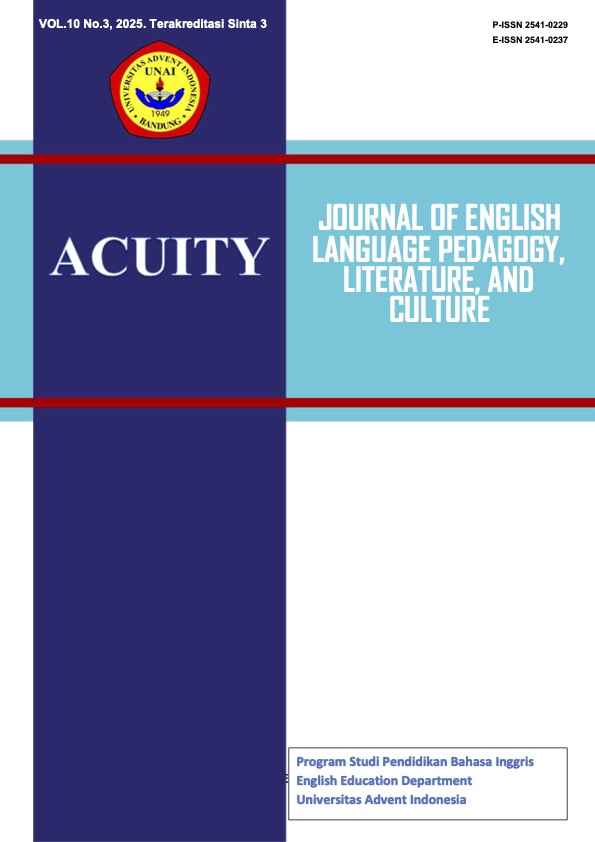Leveraging Self-Assessment to Enhance Students’ Simple Past Tense Skills at MTs Muhammadiyah Al-Haq Palu
Keywords:
Self-Assessment, Grammar teaching, Simple Past TenseAbstract
This study aims to explore the effect of self-assessment on grammar teaching and learning, by analyzing how students identify and correct errors related to the use of simple past tense in their own work. A quantitative approach was used in this study by using a quasi-experimental design. The sample was selected using purposive sampling technique. Data were collected through a test, which was divided into two: pre-test and post-test. The population in this study was the ninth grade of MTs Muhammadiyah Al-Haq Palu, where class IX C was the experimental group (n=21) and class IX B was the control group (n=18). Statistical analysis was performed using the Mann-Whitney U test due to the study data was not normally distributed. The results demonstrated that there was an increase in learning outcomes in the use of simple past tense in the experimental group, compared to the control group. It was shown by calculations using the SPSS 24 software system where the Sig (2-tailed) value = 0.000 < 0.05, which means that the null hypothesis is rejected and the alternative hypothesis is accepted. In summary, this study indicated that self-assessment has a significant impact on enhancing students’ ability in simple past tense. The findings offer a new perspective for students, teachers and future researchers in enhancing English language teaching and learning.
Downloads
References
Alam, T. G. M. R. (2019). Comparative Analysis Between Pre-Test/Post-Test Model and Post-Test-Only Model in Achieving the Learning Outcomes. Pakistan Journal of Ophthalmology, 35(1).
Andriani, A., Yuniar, V. D., & Abdullah, F. (2021). Teaching English Grammar in an Indonesian Junior High School. Al-Ishlah: Jurnal Pendidikan, 13(2), 1046–1056.
Azar, B. S. (2003). Fundamentals of English grammar. Longman.
Cohen, L., Manion, L., & Morrison, K. (2007). Research Methods in Education, 6th ed. Routledge/Taylor & Francis Group.
Creswell, J. W. (2003). Research Design: Qualitative Quantitative and Mixed Method Approaches aed.
Daskan, A. (2023). The Challenges of Grammar Learning and Teaching and Students’ Perceptions in EFL Classes--Tishk International University, Erbil Case. International Journal of Social Sciences & Educational Studies, 10(3).
Eswaey, G., & Ihmoumah, H. (2024). Role of Self-Assessment in Improving Students’ Writing: A Systematic Review. AlQalam Journal of Medical and Applied Sciences, 94–106.
Fitria, T. N. (2023). Non-EFL Students’ Perception of Grammar and Their Ability in Understanding Basic Grammar. Anaphora: Journal of Language, Literary, and Cultural Studies, 6(1), 75–89.
Guo, C. (2023). Exploring Common Grammatical Errors in Chinese Students Writing. Lecture Notes in Education Psychology and Public Media.
Jamrus, M. H. M., & Razali, A. B. (2019). Using Self-Assessment as a Tool for English Language Learning. English Language Teaching, 12(11), 64–73.
Khonamri, F., Kralik, R., Viteckova, M., & Petrikovicova, L. (2021). Self-Assessment and EFL Literature Students’ Oral Reproduction of Short Stories. European Journal of Contemporary Education, 10(1), 77–88. https://doi.org/10.13187/ejced.2021.1.77
Larandang, B., Thamrin, N. S., Naniwarsih, A., & Aminun, F. (2023). Journal on English as a Foreign Language The Top-Down Strategies in an EFL Class of the Vocational High School : an Experimental Study on Enhancing Students’ Listening Comprehension Skills. 13(2), 399–426.
Larsari, V. N., Dhuli, R., & Koolai, Z. D. (2023). An Investigation into the Effect of Self-assessment on Improving EFL Learners’ Motivation in EFL Grammar Achievements. Journal of English as a Foreign Language Teaching and Research, 3(1), 44–56.
Moqbel, M. S. S. (2018). Self--Assessment in EFL Grammar Classroom: A Study of EFL Learners at the Centre for Languages and Translation, Ibb University. International Journal for Research in Education, 42(2), 289–324.
Noviyenty, L. (2022). English Speaking Lecturers’ Performances of Communication Strategies and Their Efforts to Improve Students’ Communicative Competence. Europan Journal of Educational Research, 11(2), 1047–1062.
Papaioannou, M. (2011). Simple Verb Tenses. https://api.semanticscholar.org/CorpusID:124827450
Piercy, J. (2014). The 25 Rules of Grammar: The Essential Guide to Good English. Michael O’Mara Books.
Priyatni, J. A., Aprilliaswati, R., & Supardi, I. (2019). Self-Monitoring Strategy in Improving Students’ Ability in Using Simple Past Tense In Recount Text. Jurnal Pendidikan Dan Pembelajaran Khatulistiwa (JPPK), 8(10).
Purwanti, T. T. (2015). The implementation of self-assessment in writing class: A case study at STBA Lia Jakarta. Teflin Journal, 26(1), 97.
Ramdani, A. S., & Purwaningsih, E. (2010). The Students' Mastery in Using Simple Past Tense of Faculty of Letters Gunadarma University. https://api.semanticscholar.org/CorpusID:54126926
Thamrin, N. S., Madya, S., Hidayanto, N., & Setyo, P. (2024). Employing Multimodal Dialogic Feedback on EFL Tertiary Students’ Writing : Formative Assessment Framework. 11(2), 124–140.
Thamrin, N. S., & Rofiqoh. (2021). The Use of the Flipped Classroom Approach to Teaching English Grammar. In Post Pandemic L2 Pedagogy (pp. 60–65). Routledge.
Thomas, F. B. (2022). The Role of Purposive Sampling Technique as a Tool for Informal Choices in a Social Sciences in Research Methods. Just Agriculture, 2(5), 1–8.
Williams, C. (2011). Research Methods.[JBER]. Journal of Business & Economics Research, 5(3).
Yan, Z. (2020). Self-Assessment in the Process of Self-Regulated Learning and Its Relationship with Academic Achievement. Assessment & Evaluation in Higher Education, 45(2), 224–238.

















